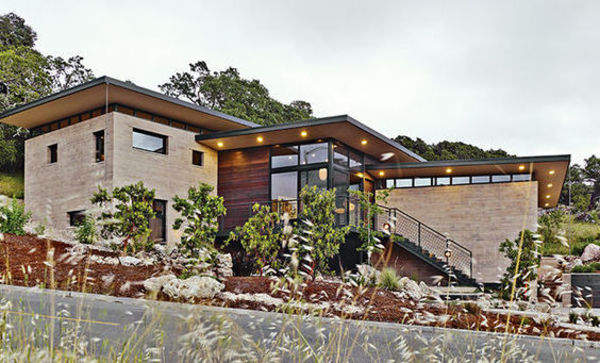
This may be the biggest story of the year. I just found out more information about the clay masonry blocks we reported on the other day. It turns out they were invented by rammed earth expert David Easton, and the blocks are already for sale in northern California in the San Francisco area. That means the development of Watershed Materials earth blocks are much farther along than I realized. This is VERY good news for natural builders and so I will do additional blog posts on this subject. Today’s blog post is about David Easton’s new home that’s made with these clay blocks.
“David Easton, a pioneer in the field of rammed-earth construction, developed sturdy blocks made from recycled and waste material and then used them to build a house for himself and his wife, Cynthia Wright, in collaboration with designer Juliet Hsu.
David Easton, the founder of a Napa, California, company called Rammed Earth Works, has built more than 300 rammed-earth homes in 35 years. He completed another in 2013, this time with one crucial difference. This relatively modest 3,000-square-foot house was made—without building forms— of rammed-earth blocks.
“An inexpensive rammed-earth house had been my unrealized dream,” Easton says, “until it dawned on me that a better concrete block—one of the most common building components in the world, but made of earth that you could pick up and lay together to form a wall—could be more effective for modern construction.”
Easton promptly started Watershed Materials, a company that makes lithified building blocks, bringing the thermal, ecological, and aesthetic advantages of rammed-earth homes within reach of more people by bypassing the expensive molds generally used in this type of construction.
“Our Watershed blocks are made from local raw material to embody the character of the region,” Easton explains. The blocks are eco-friendly and economical in other ways as well. Bonded together with a matching mortar, they require no surface finishes inside or out, and, because of their thick thermal mass, they need no artificial insulation [in their climate].”
More at the source: Dwell
From the Journal of the American Institute of Architects
“… a new masonry unit from Watershed Materials made of fused soil and rock fragments, including quartz, feldspar, clay, and other minerals. The hollow-celled blocks each weigh approximately 30 lbs.—up to 15% more than standard concrete blocks but with half the cement content. The variety of each one’s contents results in color variation emulating natural rock forms. The blocks measure 16” long, 8” tall, and 4”, 6”, or 8” deep.”

Is there any forms to apply for training? What days of the week trainings are available and what time does it start. I am at kathmandu at the moment. Is there any fees for training. Any link would be great.
CHEERS
If you’re in KM only for a short time then email me: naturalhouses [AT] gmail.com
Earthbag Rebuild Nepal Owen Geiger training page: https://www.facebook.com/groups/1613996712180913/
To register: Please complete the following google form:
https://docs.google.com/a/firststepshimalaya.org/forms/d/1u8zQ5tRwupG7PiX_dI0ZPE5qD9LGda5T8k_KhK63PSY/viewform
Are you in Nepal? Would like to meet you. Please feel free to call or leave sms st 00977-9840056277
Yes. But I don’t have a phone. I work by email only.
Hi
where in Nepal are you. I would love to meet you and volunteer as well at the same learn the skill. Please let me know so that i can arrange to visit you. Can you please drop email at bimal.khen@yahoo.com.
Sincerely
Bimal
Osho Tapoban outside Kathmandu. Come any time.
thank you for your response. Looking forward to meet you up on Saturday hopefully. just want to know how long will you be staying in Nepal?
For about one more month. I may stay longer if big projects emerge.
Your informations are very interesting. I am looking forward to build up some clay houses in Nepal. The neighbours of us, where we live when we are in Nepal, lost also their houses. My interesting is to vuild houses with their own materials if it is possible. Thank you for your engagement and your visions.
Yours Helga Hagen-Weinzetl
The best building method for Nepal that’s available now is earthbag building. Search our blog for previous stories. I’m coming to Nepal in about two weeks to train local builders.
They keep getting better and better. Thanks for the update Owen!
The hollow blocks make it easy to add reinforcing and cavity insulation. The current blocks use some cement (less than 50% of cement blocks), but they hope to reduce this to 0% by improving the block making process. They’re already way greener than cement blocks because they use waste clay and minerals from abandoned quarries versus virgin sand and gravel.